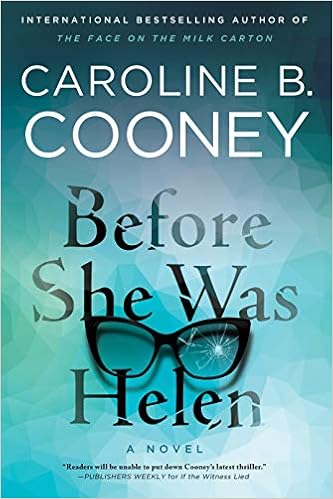Clemmie Lakefield is a semi-retired Latin teacher living in a retirement community in South Carolina. Because she hasn’t heard from her neighbour Dom, she lets herself into his home. She doesn’t find Dom but she sees a door connecting Dom’s unit with the neigbour’s, and she can’t help but snoop. She discovers a beautiful piece of glass art, and she can’t resist taking a photo. This picture she shares with her grand-nephew who then shares it on social media and thereby inadvertently places his great-aunt in a dangerous situation involving a drug dealer. Then, a body is discovered next door. Clemmie worries that her real identity will be revealed and that she will not only be implicated in the murder next door but connected to a 50-year-old murder case which has recently been re-opened.
There are actually two narratives in the book. One involves the present where Clemmie, a
septuagenarian, is living as Helen Stephens.
Interspersed are flashbacks to the 1950s when Clemmie was a teenager and
young woman; these flashbacks explain how and why Clemmie became Helen.
Other than Clemmie, none of the other characters are developed in any
depth. Many are portrayed as rather stereotypical
seniors whose lives revolve around card games, golf, line dancing, gardening,
art classes, and book clubs. Many are
also nosy busybodies whose behaviour and gossiping provide several touches of
humour.
It is Clemmie’s young life in the 1950s which has no humour in it. She suffered a tragedy which has shaped her
life. Since what happened to Clemmie
would (hopefully) not be regarded in the same way today, the author takes great
pains to explain what life was like in the mid-20th century. There are several passages explaining life in
the past: “Promiscuity in the 1950s and
early 1960s was rare. The price to be
paid was too high. . . . There was birth control in the form of condoms, but
few girls could picture how that worked, let alone acquire such an item. The pill had not yet been invented. The only way to avoid pregnancy was not to
have sex” and “There were no divorces to speak of in the early 1950s” and “In
the 1950s . . . hardly anyone had a passport or went abroad” and “in the 1950s,
you didn’t confess you had a problem because it was wrong to burden
others. Presenting your own problem was
nothing but whining. Furthermore, in the
1950s, people just soldiered on” and “in the 1950s and well into the ‘60s, you
protected your enemy because of your firm belief in courtesy and your need to
retain your community standing” and “The word stalking had not been used for people in the 1950s and ‘60s.”
There are two murder cases and neither is resolved realistically. The resolution of one seems contrived and
that of the other seems a cop out. There
are other issues as well: the re-opening
of a 50-year-old murder case just as Clemmie becomes involved in a murder next
door is just too coincidental, and the clueless behaviour of the grand-nephew
is unconvincing.
Despite its flaws, the book is an easy, entertaining read. A reader will inevitably find him/herself
cheering for Clemmie and hoping she escapes all the dire consequences she
fears.
Note: I received a digital
galley from the publisher via NetGalley. The book will be released on September 8, 2020.

No comments:
Post a Comment